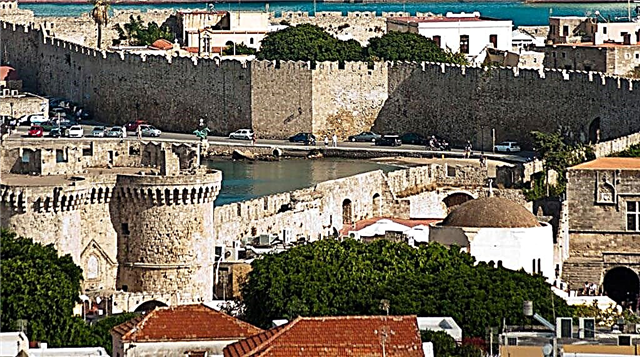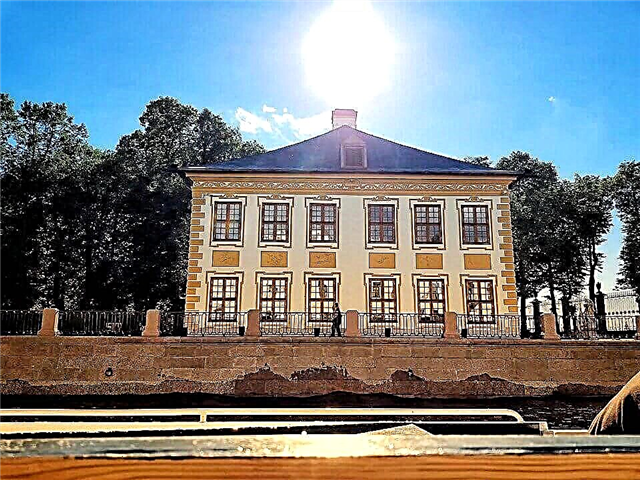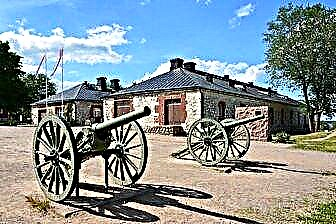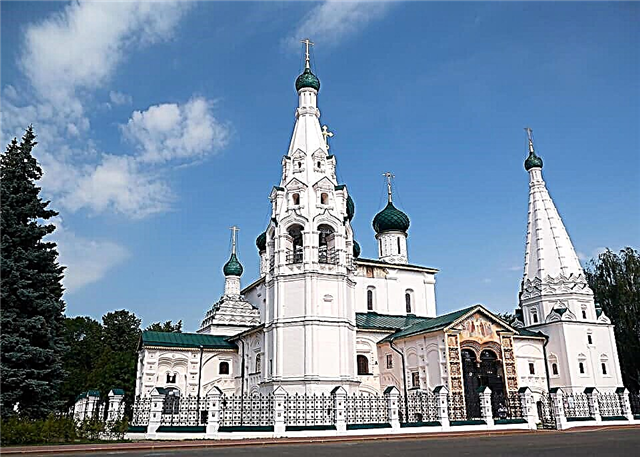The ancient city of Russia, located on the Volga shores, was founded by Yuri Dolgoruky in 1152. Today Kostroma is a famous river port, regional center and a popular tourist attraction. It can be called a pearl in the necklace of the Russian cities of the Golden Ring. Their age-old history is inseparably linked with the history of the country, Russian princes and tsars. The old part of Kostroma is an open-air museum. The special flavor of the Volga merchant city in the past fascinates. Ancient churches and temples of Kostroma, shrouded in a haze of legends and secrets, fascinate with their appearance.
Holy Trinity Ipatiev Monastery

The oldest monastery in Russia is located in a picturesque place where the Kostroma River flows into the Volga. There is a legend about the founder of the male monastery associated with the name of the Tatar nobleman Chet from the Godunov family. During a trip to Moscow, he fell ill and stopped at the confluence of the rivers Kostroma and Volga. In a dream, the Mother of God, the great martyr Hypatius and the Apostle Philip appeared to him, after which Chet recovered.
Later, he was baptized into Orthodoxy under the name Zacharius and erected in this place the Ipatiev Monastery, which is considered the cradle of the Russian tsars. Having survived flourishing, oblivion and devastation, the holy monastery today is an active male monastery. In fact, this is a monastery complex, consisting of a monastic territory inaccessible to visitors, and the Church Historical and Archaeological Museum. For everyone, the Holy Trinity Cathedral is open, where the miraculous icon of the Tikhvin Mother of God is kept.
To worship her, pilgrims come here from different parts of the world. Among the monastery shrines there are particles of the Lord's robe, the relics of Saint Hypatius in the icon, the head of the holy fool Simon Yurevetsky, the execution stone of the Ipatiev house. One cannot but admire the magnificent view of the monastery buildings, the beautiful well-groomed territory of the monastery.
Church of Elijah the Prophet

The old stone church building 17th century has long been positioned as a temple of the military. There is no information about the builders of the main building, and the high 3-tier bell tower was built at the expense of the merchant Malyshev in 1829. Otherwise, the 3-domed church is referred to as the Cossack-Ilyinsky temple, where active soldiers, retirees, Afghan veterans, and participants in the fighting in Chechnya come.
The bell tower was recently rebuilt, on which a spire with a cross was erected. This was done with voluntary donations from the military and actors, including Boris Galkin. Further reconstruction of the ancient shrine is planned. It is planned to rebuild a quadrangle of the temple, on the site of the former checkpoint of the main post office. The paperwork is already underway, preparatory work is underway, and excavations will be carried out. The church has 3 thrones: Elijah the Prophet, the Mother of God and St. Alexei, 3 Holy Hierarchs Universe.
The celebration in honor of the image of the Mother of God takes place on 1 September. Traditionally, on the eve of the new school year, a prayer service is held in the church for schoolchildren and students. After the prayer service, they are blessed to study, sprinkled with holy water.
Church of the Resurrection of Christ on Debra

Walking along the Nizhnyaya Debrya street, you cannot pass by the most beautiful building located on it. This is the Resurrection Church, captivating with the external beauty of its forms and colors. It is the only one of the surviving township religious sites of the 17th century. The name of the street comes from the dense coastal thickets - wilds. And the place where the beautiful church stands was also covered with impenetrable vegetation.
According to legend, the stone temple was built at the expense of the wealthy merchant Isakov (1645-52), whose ashes are buried in the basement of the constructed sanctuary. The stone structure is built on a high foundation. Its 5 chapters rest on massive drums, the patterned towers are decorated with domes with crosses. The best traditions of Russian Orthodox architecture are embodied in the appearance of the Church of the Resurrection of Christ.
The Holy Gate at the main entrance can be regarded as an artistic masterpiece of stone architecture. Above the arched openings, there are three graceful faceted tents crowned with domes. They are lavishly carved with multicolored tiles. On the walls of the gate, symbols of the resurrection are placed - figurines of a unicorn, lion, owl, eagle and siren made of white stone. Inside, the beauty of the 5-tier iconostasis (Trekhsvyatsky side-altar) is striking - an invaluable monument of the applied art of Russia.
The thin wood carving covered with gilding and paints amazes. There are several ancient icons and frescoes - real masterpieces of 17th century icon painting. Currently, various services are regularly held in the Resurrection Church.
Church of the Apostle and Evangelist John the Theologian

Next to the Ipatiev Monastery, in the former Theological Quarter, there is another ancient religious site - the Church of the Apostle and Evangelist John the Theologian. Today it is a cultural and historical monument17 of federal significance. Each new century made changes in the appearance of the temple. In the 18th century, a southern porch was added, fenced off from 3 sides with a brick wall with 2 gates.
In the 19th century, a fence was added from the west and a refectory was erected. Reconstructions continued during the Soviet years. How not to admire the openwork lattice in the Baroque style, round domes, slender bell tower. Everything here is truly beautiful. The interior interiors delight the eye with wall frescoes of the 18th century, which were worked on by the city's best iconographers. After cosmetic restoration, the murals have retained their original appearance.
The murals depict 4 storylines: The Passion of Christ, Christology, Akathist of the Mother of God, the deeds of the Apostle John the Theologian. The paintings on the northern wall are dedicated to Nicholas the Wonderworker. The frescoes of the south porch (late 19th century) illustrate the life of the Theologian and apocalyptic scenes. The shape of the 19th century iconostasis has been preserved, and there are many originals among the icons. The Church of St. John the Theologian is a striking example of 17th century Kostroma architecture and 18th century art paintings.
Epiphany-Anastasiin Convent

This monastery has been quoted as a miraculous place among the population for several centuries. The main shrine of the Epiphany Monastery - the icon of the Feodorovskaya Mother of God, has a beneficial effect on the parishioners. Back in the 15th century, a wooden monastery was built on this site. The construction was supervised by the disciple of Sergius of Radonezh, the Monk Nikita. A century later, wooden buildings were replaced by stone ones, and 2 female ones were added to the male monastery - Anastasiin and Holy Cross (1863).
After going through hardships and hardships, the united monastery began to revive in 1990. Of the 3 ancient cathedrals of the monastery, the Epiphany Cathedral has been preserved, rebuilt in 1869. An unusually beautiful structure that delights tourists, shines with gilded domes. The main shrine of the monastery is kept here - the miraculous icon of the Feodorovskaya Mother of God, transferred here in 1991.
In addition to her, there are other myrrh-streaming icons in the monastery: Sergius of Radonezh, Nicholas the Wonderworker, the Kazan Mother of God, etc. The relics of the saints are kept, including parts of the robe of Christ. Today there are 4 active churches in the monastery. In addition to the Epiphany Cathedral, there are the Smolensk Church, the Epiphany Cathedral and the bell tower on the territory.
Church of Alexy, the man of God

Being in the very center of the city, you involuntarily pay attention to the neat stone structure with a high bell tower at the top. The unusual architectural form with baroque elements, the delicate coloring of the walls, the gilded crown on top make you stop near it. This is the Church of Alexy, the Divine Man, which appeared here in the 18th century.
In the 17th century in this area there was Gasheevskaya Sloboda (its inhabitants extinguished lime), located on the northern outskirts. Initially, the 1-storey building, named after St. Alexis, was made of wood. Instead, a stone 2-storey church with a bell tower was built. Later, it was surrounded by a fence made of metal lattice with square semi-columns.
The crown at the top of the bell tower is evidence of closeness to the royal family. After the birth of Alexei's son, Tsar Mikhail Romanov, the new building retained its former name. In the church there are 3 thrones in honor of the saints: Basil the Great, Demetrius (Metropolitan of Rostov), the Monk Alexy, the man of God.
John Chrysostom Church

The 18th century church enchants the guests of the city with its bright, colorful appearance, patterned bell tower, helmet-shaped domes. It was named John Chrysosto and has been serving people for 250 years. Until 1751, a temple made of wood stood on this site. Its construction, according to documents, was sponsored by the first tsar from the Romanov family.
Then, instead of a wooden one, a stone church was erected, in the architecture of which features of the pre-Petrine era, baroque and classicism were intertwined. All the years of its existence, services did not stop here, the doors were open for parishioners even during the years of persecution. The beautiful church appeared thanks to the financial support of a wealthy merchant Aravin.
At first, divine services were held only in the warm season, and in winter, parishioners visited the old church with heating. At the end of the 18th century, the new sanctuary was expanded with 2 heated chapels dedicated to the great martyrs Florus and Laurus, the icon of Our Lady of Tikhvin and Dmitry Salunsky.
St. Seraphim Church

A new religious object appeared in the Malyshkovo metro area quite recently. St. Seraphim Church, built in the Roman style, was designed by the architect in 1994. Then the first stone was laid in its foundation, but construction began only in 2003. The parishioners visited the old church, located in the former zemstvo school - a historical monument in 1907.
After the fire in 2008, the wooden building burned down. Only then did the construction progress, and in January 2015, the consecration of the new church took place. The architect Vasiliev, who designed the object, made it in the Roman style. The majestic building with 5 chapters, in beige tones, looks very picturesque surrounded by curly green birches.
The bell tower with a helmet-shaped dome and a cross is attached to the side façade, making up a single whole. Experienced craftsmen and artists participated in the interior paintings, who managed to create three-dimensional images that carry spiritual meaning. The themes of the frescoes are very diverse: angels, faces of apostles, saints, sacraments, Russian princes, etc.
Church of the Holy Martyrs Alexander and Antonina in Selishche

This religious site is unique in that it is the only one in the world dedicated to Saints Alexander and Antonina of Rome. There is an interesting story of his appearance in the village of Selishche, which entered the city limits in 1932. The church chronicle (1870-1917) describes an ancient belief about how, during the trip of an eminent nobleman with a pregnant wife, she gave birth to twins at this very place.
This event took place on June 23 (new style), the day of the Roman saints. The son was given the name Alexander, and the daughter - Antonina. The grateful father (meaning Zachary) built a wooden church here in honor of the saints as a token of gratitude. Today, the blue and white church looks great. A stone building instead of a wooden building in Selishche was erected in 1779-86.
Every year the miraculous Feodorovskaya icon was brought here on Alexander's day. During the period of persecution against Russian Orthodoxy, the church was not closed, thanks to the intercession of the parishioners. In the 90s of the 20th century, the Alexander-Antoninsky church received a new development. They installed a new bell weighing 16 pounds, brought 12 smaller bells, opened a Sunday school.
Today, the sanctuary contains the image of Nicholas the Wonderworker, particles of the relics of St. Clement, Panteleimon, F. Ushakov and Valerian. The hieromonk of Turin presented the main relic to the temple - a piece of the relics of Alexander.
Church of the Holy Apostles Peter and Paul

The modern Panovo neighborhood was decorated with a new building of a religious cult in 2003, when it was consecrated in January. The construction of the Petrovo-Pavlovsky Church began in 2001 with the financial support of the printing plant and the publishing house "Kostroma" on the initiative of its head PN Rusinov. The small consecration of the object, carried out by Archbishop Alexander of Kostroma, took place in a solemn atmosphere.
After the bell tower with a belfry was put into operation in 2012, the Great Consecration of the church premises took place. The Apostles Peter and Paul are revered by believers as the most zealous disciples of Christ, actively preaching the Gospel. The new church was named in their honor, but apart from them, the Monks Adrian and Theodosius of Munzensky and Therapont are venerated here.
The remake temple is very beautiful, has an unusual architecture and attracts everyone's attention with its originality. The side facades of the 1st floor have rounded shapes with a semicircular roof. The walls of the second floor end with a roof typical of the old royal chambers. The pink-terracotta color of the walls makes the building joyful and cheerful.
Church of the Savior in Ryady

Visitors to Gostiny Dvor (Ryadov) always speak enthusiastically about the ancient church located on the adjacent territory. The snow-white beauty, sparkling with green domes and gilded crosses, attracts the eye. One cannot help but admire the graceful structure - the 3-tiered bell tower.
Attention is drawn to the features of Old Russian religious architecture: side-altars, chapter 5, loopholes. Although the building was erected during the reign of Catherine II, the builders preserved the architectural elements of the 17th century. At the beginning of the 17th century, here, at a trading place, near the Kremlin, there was a wooden Church of the Savior.
The stone building was erected in the middle of the 18th century with donations from the noble merchant S.S.Belov. At first, the church was consecrated in honor of the Life-giving Cross of the Lord, but the parishioners continued to call it Spasskaya. The former name has been stuck with it to this day. A sweet old man, captured in the Church of the Savior, pleases the soul.
Church of the Icon of the Mother of God of the Sign

In 1993, the Znamensky Women's Monastery was opened in the city, including 2 ancient cult objects: the Znamenskaya and Resurrection Churches. Both structures experienced a difficult fate, were closed for a long time and did not function. Znamenskaya Church is the main sanctuary of the monastery. The first mention of it dates back to the 17th century. like the Church of St. George.
Presumably, it was built before 1628. But in 1799-1802, after reconstruction, it was consecrated in honor of the Icon of the Mother of God of the Sign. Here are kept rare icons of the Mother of God of the Sign, Cosmas and Damian and Procopius of Ustyuzhansky. The multi-tiered bell tower was thoroughly destroyed in the 30s. It is known that in 1913 the royal family of Nicholas II climbed on it, admiring the Volga landscapes. The restoration of the religious site began in 2001.
With charitable financial support, the high bell tower was rebuilt, captivating others with its slender grace. The structure that adorns the territory of the monastery is really magnificent. After renovation works, the church acquired its original appearance.
Transfiguration Church

An irresistible impression on everyone is made by the snow-white church building, the graceful bell tower with the cone-shaped belfry of the Transfiguration Church. The building looks especially beautiful in the summer among curly greenery against the blue sky. The Church of the Transfiguration of the Savior was erected at the turn of the 18th century to replace the old wooden church with public donations.
When the Old Believers who left the borders of central Russia during the schism were allowed to return to Kostroma at the end of the 20th century, they were given this object.Since 1998 the Church of the Transfiguration of the Savior has become the cathedral of the local Old Believers. Thanks to the text on the foundation slab, the temple was able to return to its original appearance. The square quadrangle of the main building with 3 apses has 5 chapters.
The corners are decorated with small decorative domes, and the center is crowned with a more massive cupola. Old kokoshniks are sculpted over the windows. On the wall of the entrance portal there is a tiled image of St. George the Victorious piercing a snake. Inside, restored frescoes shine under the ceiling.
Church of the Savior on Zaprudna

Almost every religious site in the city is shrouded in legends associated with the names of saints. A striking example is the Church of the Savior on the Dam. There is a popular belief about the history of its appearance about the Feodorovskaya icon of the Mother of God. Her image appeared to Prince Vasily Yaroslavich (younger brother of A. Nevsky) in the middle of the 13th century on the banks of the river. Dam. Here a church and a monastery were built, later replacing the wooden buildings with stone ones.
Representatives of the noble families of Kostroma are buried at the cemetery adjacent to the sanctuary. The territory of the Spaso-Zaprudnensky Church is surrounded by a brick fence with corner turrets and arched gates. Many relics are kept inside: relics of the saints: Agapit, the doctor of the Caves; blessed Augustine and others. The main symbol of worship is the icon of the Savior Not Made by Hands.
CIAM

A unique organization - CIAM (church historical and archaeological museum) - an institution created by the diocese of the Russian Orthodox Church. It is located in the Ipatiev Monastery. The establishment of the museum institution began in the 19th century, when portraits of 24 persons of the royal family were hung in the "Mikhail Romanov Palace". With them began a voluminous collection of the future museum. On the eve of the celebration of the 300th anniversary of the Romanovs (1912), the Church-Historical Society was organized in Kostroma, operating at the Ipatiev Monastery.
Religious rarities were collected in the ancient repository created here: icons, ritual accessories, monuments of ancient Russian writing and sewing. The current CIAM received the status of a museum in 2004. There are more than 3 thousand truly unique exhibits in its funds. Most of them are items that belonged to the tsarist dynasties of the Godunovs and Romanovs. Among them are liturgical books in luxurious bindings, both handwritten and printed.
Items of religious sculpture and painting, old coins, medals and signs, church items, etc. Themed exhibitions are regularly held here, demonstrating the cultural and artistic heritage of the Russian Orthodox Church. The art of ancient jewelers, icon painters, casting and carving masters is widely represented there. Among the items are true masterpieces.











